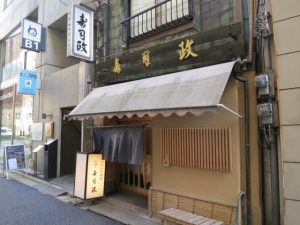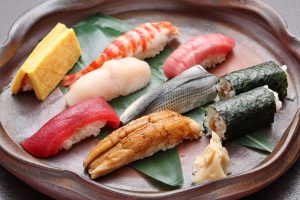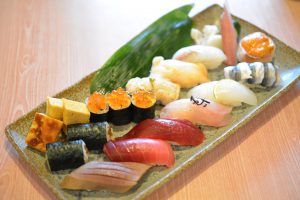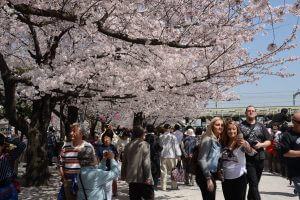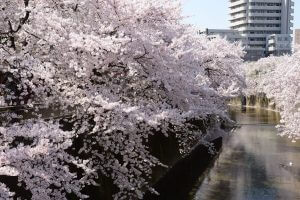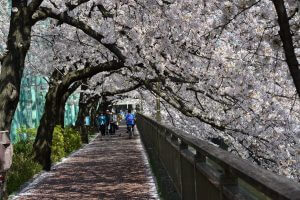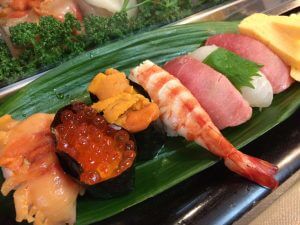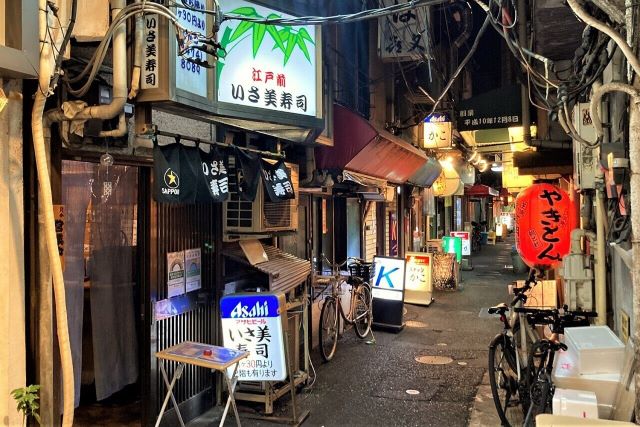
A quick cup of coffee and off to work I go. In this case, of course, you are standing rather than sitting on a chair. But when it comes to eating, sitting on a chair is the universal practice, isn’t it? In Japan, however, many restaurants allow customers to eat standing up, such as standing buckwheat noodles.
Why do these restaurants exist?
Certainly, a businessman who does not want to waste time will not allocate elegant time for a meal. In a sense, a businessman who wastes his time on such a wasteful activity may be a dropout. That said, how about eating a meal while standing up? According to Japanese eating etiquette, it is against manners to eat while standing. In many countries, it would be called ill-mannered.
And it is impossible to eat sushi, which has a strong image as a representative of high-class Japanese cuisine, standing up is not allowed. Nigiri sushi, however, was originally a yatai food (street food) for the impatient Edo people and could be called the fast food of the time. That and the fact that the customers were allowed to eat standing up and the seller sat down to make sushi, which is impossible today, but it was the norm back then.
Here, we would like to introduce Standing sushi bars in Tokyo that we would like foreigners to visit by imagining what yatai (street food) sushi was like about 200 years ago.
Standing sushi bars have been popping up in Tokyo since around 2021. It is impossible to rapidly increase the number of customers in a high-end sushi bar where the bill is several hundred dollars. Even if they opened a second sushi bar and entrusted the management to their apprentice, they would need to charge a certain amount of money to make it viable.
Therefore, the number of “standing sushi bars” should have increased to encourage people to come to the restaurant more casually. To be honest, while the business model was still in the exploratory stage, standing sushi bar Akira was selected as a Michelin Bib Gourmand in 2022. standing sushi bar is now in the limelight.
There are currently about 50 standing sushi bars in Tokyo, and among them, I would like to introduce Isami zushi, which has a long history, is as inexpensive and delicious as Conveyor belt sushi, and has the atmosphere of a traditional sushi bar.
Turn left from the east exit of Oimachi Station, turn left at the first corner, and enter the Higashikoji street that you will see immediately. Isami zushi will be on your left.
This area is a maze of narrow alleys and side streets with 60 to 70 bars and eateries that are reminiscent of the Showa period. Although not yet well known to foreigners, it is sure to attract attention as a town where one can feel the lifestyle of the people who live there.
Isami zushi has been in business for 67 years. The current owner, Masaaki Fujioka, is the third generation and has been running the restaurant for 25 years. The restaurant has an L-shaped counter and can accommodate seven people. At best, seven Japanese women can just barely fit inside. And if I may be rude, it feels even smaller than it is because of the lack of organization and placement of things.
The price per piece of nigiri sushi is 30 yen (Geso), 40 yen (Tamagoyaki), 60 yen (Ika), 80 yen (Tobiko), 100 yen (Aji, Aoyagi, Ebi, Saba, Akami, Hotate, Iwashi). , 120 yen (Tako, Kanpachi, Kohada, Hamachi), 140 yen (Torigai, Anago, Toro, Shako), 160 yen (Makimono), and up to 200 yen (Uni, Ikura).
You can order from two pieces. There are always about 20 different kinds of neta (toppings) available. Popular toppings are sometimes sold out, so it is best to get there early. Sushi rice is not too sweet and is suitable for eating sushi with a drink. Of course, sashimi is also available, so you can drink sake as well. The rice is a blend of Koshihikari and Sasanishiki, which gives the rice a delicious flavor and a flaky texture when you put it in your mouth.
How to Order
A sushi chef does not speak foreign languages. There is no English menu, so you must choose from a wooden tag with the name of the toppings written on it, or from a whiteboard with today’s recommendation. Or you can point to the fish in the glass case. Gari is not available at the counter like at conveyor-belt sushi restaurants, so please ask the sushi chef for “Gari-Kudasai” (Kudasai is a Japanese word meaning “please” in English). And regulars order three different sushi toppings at once. In any case, the hurdle may be quite high for foreigners. Even if your sushi order does not go as expected, it is inexpensive, there are no rip-offs, and it will be a memorable experience.
Why is it dramatically cheaper?
First, the restaurant is operated by a single sushi chef, which reduces labor costs. Second, he selects fish from the Toyosu and Ota markets, and fish arrives directly from Odawara, Nagasaki, and other areas. And because he strives to sell out the sushi topping every day. Also, he has reduced the size of his shari and sushi topping compared to previous years. These efforts are nearing their limits, so there may be a price increase soon.
How do I make a reservation?
Reservations are not available, so you will have to line up before the restaurant opens. The restaurant will be full as soon as it opens. Even if you say you will wait, you do not know what time it will be. Please be patient.
Payment Method
Credit cards are not accepted. Cash only. No table charges.
Actual Eating Report
We tried it and here is our report.
Well, we ate standing up, so we thought we could only hold out for about 30 minutes, but we didn’t mind quite a bit. Before our visit, we wanted to eat about 20 pieces as a goal. Japanese people consider someone’s feelings or wishes. In other words, if you are reporting on a sushi restaurant, you should write an article that will please the owner. I will say that this report does not have that element at all.
As soon as you enter the restaurant, a geta (sushi wooden tray) is placed in front of you and you are like, “Now what shall we nigiri? We think every sushi restaurant was like this 30 years ago. First, we ordered a beer. What a surprise, a can of beer was served. In Japanese restaurants, canned beer is rarely served. This is because cans can be drunk at home, and since the price is known, customers do not have a good feeling about it.
To start the conversation, we ask about the history of the restaurant. Then we confirm that it is okay to take pictures and will explore the most important sushi chef’s personality.
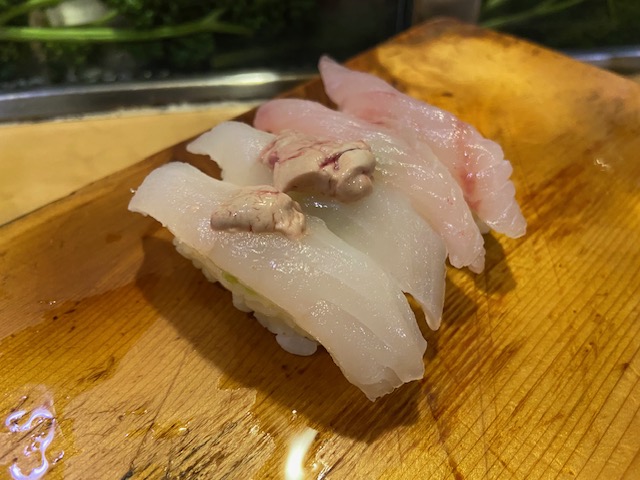
Today’s shiromi was Hokke, Black scraper (Umazurahagi), and Marbled rockfish (Kasago). All of these sushi toppings are quite rare as shiromi. They are not served at high-end restaurants by mistake. Isami zushi uses natural fish from domestic fisheries for almost all of its topping. Because they do not use any farm-raised fish, the selection of toppings changes daily, but diners can enjoy rare local fish from all over Japan.
We ordered Umazurahagi and Kasago. The customer next to us also ordered Umazurahagi without a moment’s delay, but it was hard to miss the fact that he started making his order from ours. He does not make the nigiri sushi for the sake of efficiency. And of course, the fish is kept cold in a glass case with the skin on. This prevents oxidation of the ingredients as much as possible. And since the skin is the most delicious part of the fish, this is why we want to keep it on the meat until the very last minute. These are the basics of a sushi chef.
The liver is served on top of the Umazurahagi nigiri. Liver goes bad fast. It is meant to be alive and super fresh until a few hours ago. Its taste is often compared to that of foie gras, but it is not. Natural fish liver has a decidedly better aftertaste than foie gras. It makes you want to eat another piece. Kasago used to be a popular fish in the past, but now it is popular as a high-end fish. Sushi rice enhances the sweetness of the meat and gives it a different flavor from that of Red seabream (Tai) or Bastard halibut (Hirame).
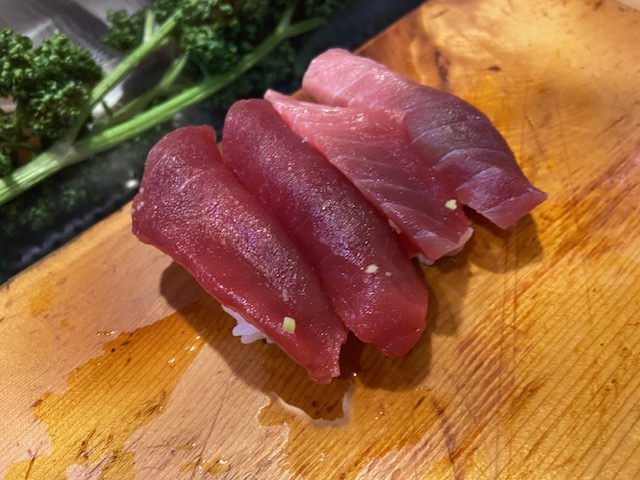
Next is the main dish, tuna. He insists on fresh, not frozen, tuna. He uses Mebachi and Minami-Maguro to keep the price reasonable. Today’s tuna was Minami-maguro. April to May is the time when the fat is removed from the meat of Kuro-maguro caught in coastal waters. Minami-maguro is next in rank to Kuro-maguro, but that is not true. Minami-Maguro is not widely distributed, so its richness is not well known. It also changes color quickly, which is its weak point.
Next is Geso, a specialty item at 30 yen per piece, Geso is squid’s leg. In fact, geso is not suitable for nigirizushi. The squid’s body is wrapped in a thin skin, and it is especially difficult to remove it from Geso. It is best for Tsumami when boiled or grilled. Fresh Geso, properly salted, has no fishy smell at all. The taste of the squid itself is concentrated. Try it with a dash of Nikiri shoyu.
Next is Aozakana (Blue-backed fish). These are caught in the morning and sent from the producing area. Today he has Horse mackerel (Aji) and Japanese sardine (Iwashi). The Aji is a top-quality fish from Amakusa, Kumamoto Prefecture, a famous fish producing area. The meat is thick and sweet when chewed. The ginger is used as a condiment to give it a refreshing taste. The Iwashi is in its peak of fatty season, and its light flavor was so delicate that one could hardly believe it was Iwashi.
Gizzard shad (Kohada) has larger pieces of sushi topping and smaller pieces of sushi rice. It is coated with a brush of Nikiri shoyu, so there is no need to dip it in soy sauce. The color is glossy and the fat is wonderful when eaten. And it is the type served at long-established sushi restaurants with the sourness of vinegar.
Shellfish available today are Ark shell (Akagai) and Common scallop (Hotate). Shellfish is a material in which it is easy to tell whether the quality is good or bad. If something tastes like chewing gum that has lost its flavor, it is not good. For Akagai, the key is whether or not the aroma of the sea pervades your mouth. Of course, the shells were removed after receiving the order. This way, the aroma of the sea does not escape. At first glance, the small-sized Hotate did not seem to have much sweetness, but I was impressed by its modest and elegant sweetness.
If we dare to make a bad comment after eating here, both the sushi topping and the sushi rice are 30% smaller than they were a few years ago. But that’s no surprise. They haven’t raised their prices even though prices have skyrocketed so high. In these days of conveyor-belt sushi, the toppings are as flimsy as paper.
Today we ate 18 pieces of nigiri sushi and 1 piece of Makimono in less than 1 hour. It is not painful at all to stay standing. Sushi is served on time, so you don’t have to wait around for it. And all this for only US$30. I think you can experience nigiri sushi to the fullest.
Basic Information
Address: 5-3-13 Higashioi, Shinagawa-ku, Tokyo
TEL: +81-3-3474-8089
: 1 minute walk from East Exit of JR Oimachi Station
Business hours: 18:00-23:00 (closes when all toppings are gone)
Closed: Saturdays, Sundays, and national holidays
[sc_apply url=”https://sushiuniversity.jp/apply/”]
We hope this information will be helpful.

Revision date: March 19, 2024
Share this article
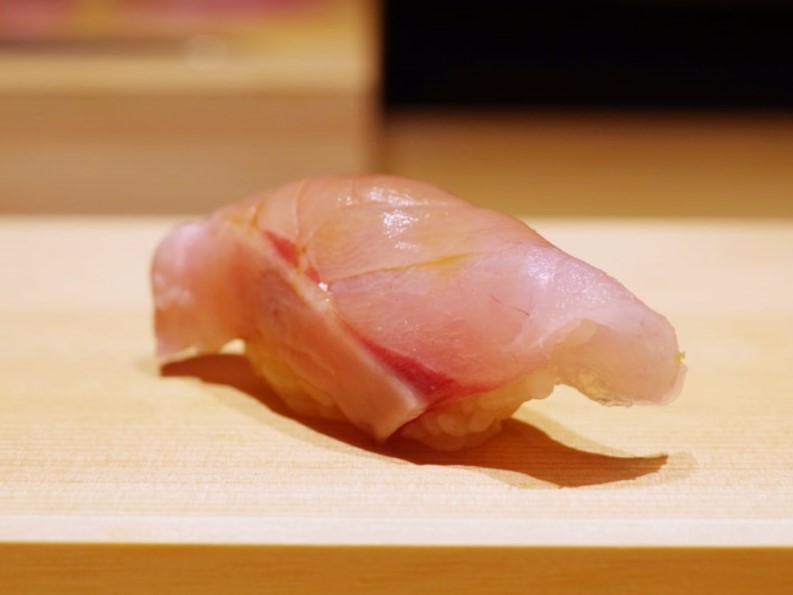
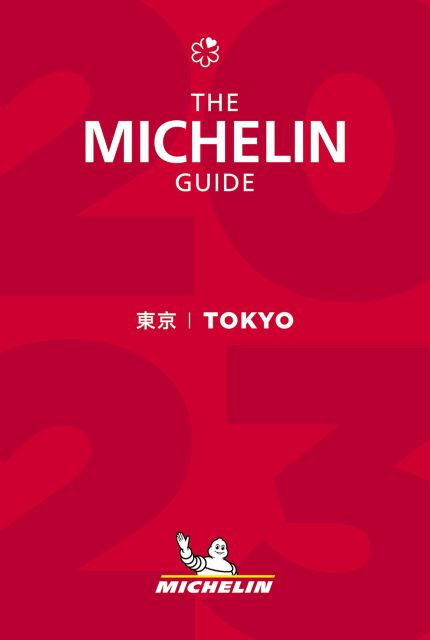

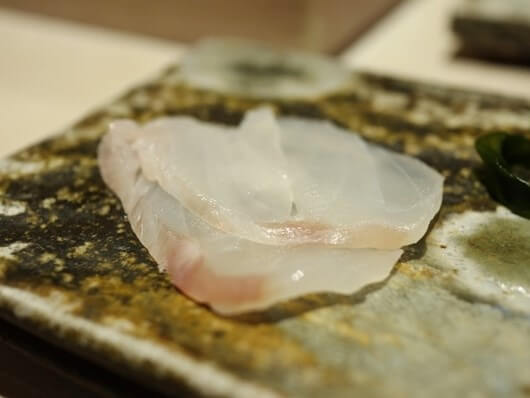
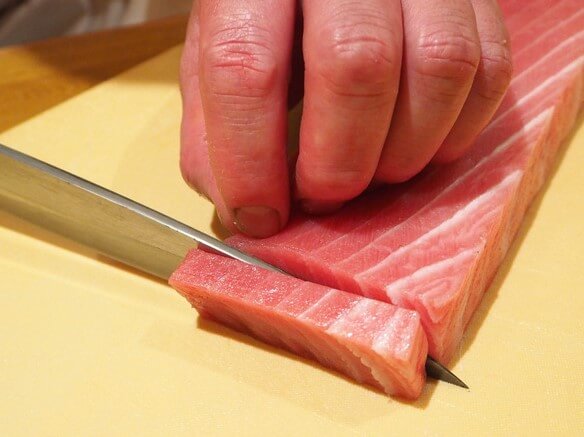
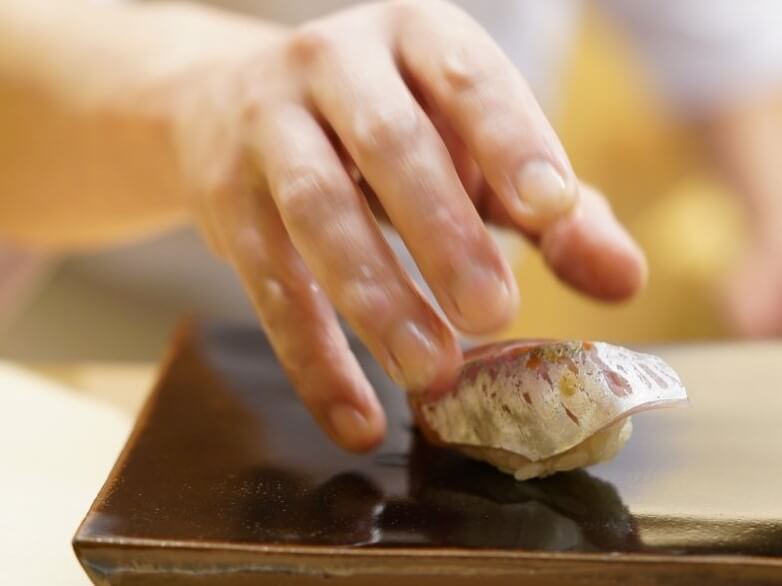 Even Japanese people can be overwhelmed by the somehow special atmosphere when they sit down at the sushi counter. This continues even when starting to eat. Other customers are concentrating on eating, quietly. You kind of get the feeling that if you utter anything, you will be asked to leave. If you don’t end up mustering up the courage, you just end up paying the high price for your meal and going home without much more to say of the evening.
Even Japanese people can be overwhelmed by the somehow special atmosphere when they sit down at the sushi counter. This continues even when starting to eat. Other customers are concentrating on eating, quietly. You kind of get the feeling that if you utter anything, you will be asked to leave. If you don’t end up mustering up the courage, you just end up paying the high price for your meal and going home without much more to say of the evening.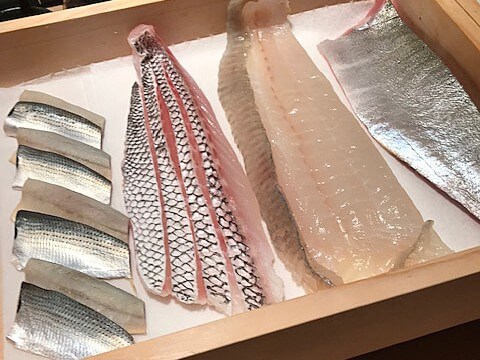 The customer ends up not remembering which fish they ate. For example there are very few people who can name the order of the 15-piece Omakase course they ate. You may be sure you ate tuna. But where was it caught? Was it the belly side or the back side? How long had the fish been matured? To be a bit more frank, how much did it cost? If you ask the chef these questions, next time you visit, you’ll be able to compare different taste based on the fishing location. Knowing the difference in taste based on the part of the fish, and difference in flavor depending on where it was procured, and different taste depending on the preparations will certainly improve your sushi literacy remarkably. It will also lead to a better awareness of your own taste preferences.
The customer ends up not remembering which fish they ate. For example there are very few people who can name the order of the 15-piece Omakase course they ate. You may be sure you ate tuna. But where was it caught? Was it the belly side or the back side? How long had the fish been matured? To be a bit more frank, how much did it cost? If you ask the chef these questions, next time you visit, you’ll be able to compare different taste based on the fishing location. Knowing the difference in taste based on the part of the fish, and difference in flavor depending on where it was procured, and different taste depending on the preparations will certainly improve your sushi literacy remarkably. It will also lead to a better awareness of your own taste preferences.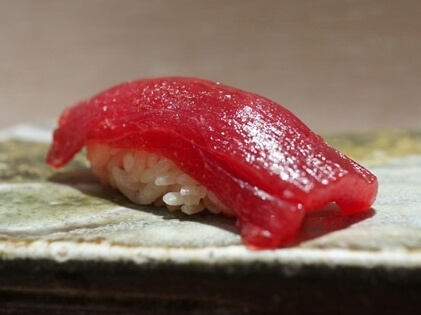 Tuna at top-end restaurants is light in flavor. Its Akami (red meat) has an indescribable acidity with a delicate harmony between the shari vinegar, the nikiri soy sauce, and wasabi. However, on the other side of the coin, it feels almost like a waste to eat it without a sense of luxury. Of course tuna with delicious akami, also has delicious fatty tuna (toro). And you’ll never get tired of it. It would be easy to polish off 10 pieces as a light snack. Contrary to popular belief, it’s not the high fat content that makes it so easy to eat. However, it is because of that popular belief that many people feel that the big chain store
Tuna at top-end restaurants is light in flavor. Its Akami (red meat) has an indescribable acidity with a delicate harmony between the shari vinegar, the nikiri soy sauce, and wasabi. However, on the other side of the coin, it feels almost like a waste to eat it without a sense of luxury. Of course tuna with delicious akami, also has delicious fatty tuna (toro). And you’ll never get tired of it. It would be easy to polish off 10 pieces as a light snack. Contrary to popular belief, it’s not the high fat content that makes it so easy to eat. However, it is because of that popular belief that many people feel that the big chain store 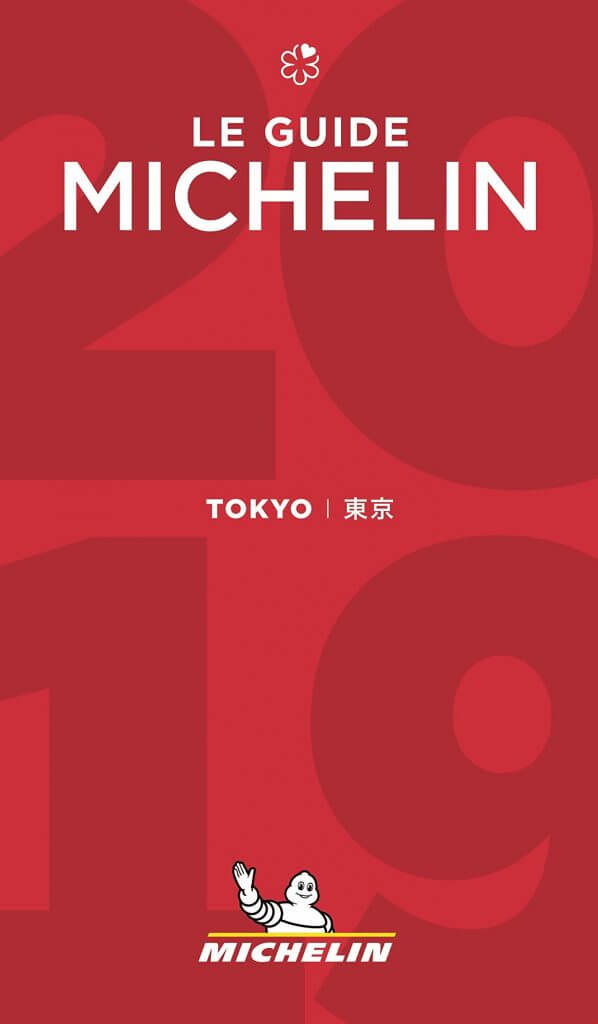 The other day I had a very interesting guest at Sushi University from America. We’d like to introduce them to you. It was their first time in Japan and they stayed in Tokyo for a week. They planned to see Asakusa, the Shibuya scramble crossing, Meiji Shrine, the robot restaurant and all the other usual tourist sites. However, the conversation all seemed to be focused on food.
The other day I had a very interesting guest at Sushi University from America. We’d like to introduce them to you. It was their first time in Japan and they stayed in Tokyo for a week. They planned to see Asakusa, the Shibuya scramble crossing, Meiji Shrine, the robot restaurant and all the other usual tourist sites. However, the conversation all seemed to be focused on food.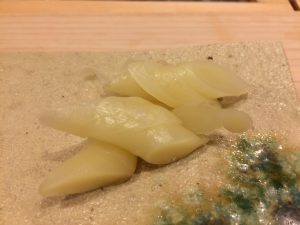 However, at high-end or traditional sushi restaurants where artisanal gari is made in-house, it may be included in the bill. This is because crafting delicious, high-quality gari requires considerable time, skill, and labor, and the cost of fresh, domestic ingredients can be so high that serving it for free would result in a financial loss.
However, at high-end or traditional sushi restaurants where artisanal gari is made in-house, it may be included in the bill. This is because crafting delicious, high-quality gari requires considerable time, skill, and labor, and the cost of fresh, domestic ingredients can be so high that serving it for free would result in a financial loss.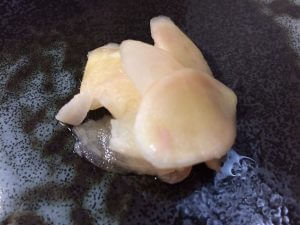
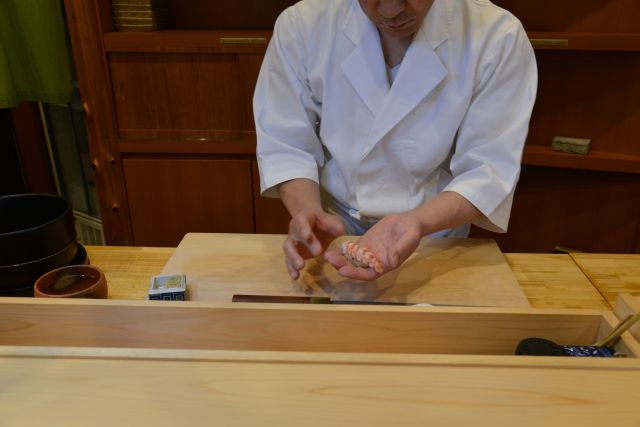
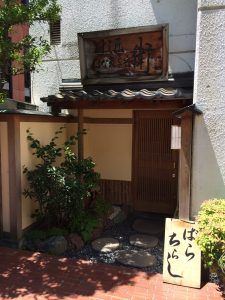 Sushi Sho (in Yotsuya) is a restaurant where you cannot make a reservation easily. Its founder,
Sushi Sho (in Yotsuya) is a restaurant where you cannot make a reservation easily. Its founder,  Kozasazushi (in Shimokitazawa) was opened by the legendary sushi chef, Shuzo Okada (passed away in May 2004). His successor, Tsutomu Nishikawa was, of course, his apprentice. The Omakase course is not an option at this restaurant. The only way to order is to look at the topping board and choose for yourself. This is a shop for experts and may be difficult for guests who can’t read or speak Japanese.
Kozasazushi (in Shimokitazawa) was opened by the legendary sushi chef, Shuzo Okada (passed away in May 2004). His successor, Tsutomu Nishikawa was, of course, his apprentice. The Omakase course is not an option at this restaurant. The only way to order is to look at the topping board and choose for yourself. This is a shop for experts and may be difficult for guests who can’t read or speak Japanese.